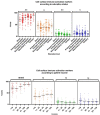Inflammatory pathways amongst people living with HIV in Malawi differ according to socioeconomic status
- PMID: 34432828
- PMCID: PMC8386842
- DOI: 10.1371/journal.pone.0256576
Inflammatory pathways amongst people living with HIV in Malawi differ according to socioeconomic status
Abstract
Background: Non-communicable diseases (NCDs) are increased amongst people living with HIV (PLWH) and are driven by persistent immune activation. The role of socioeconomic status (SES) in immune activation amongst PLWH is unknown, especially in low-income sub-Saharan Africa (SSA), where such impacts may be particularly severe.
Methods: We recruited Malawian adults with CD4<100 cells/ul two weeks after starting ART in the REALITY trial (NCT01825031), as well as volunteers without HIV infection. Clinical assessment, socioeconomic evaluation, blood draw for immune activation markers and carotid femoral pulse wave velocity (cfPWV) were carried out at 2- and 42-weeks post-ART initiation. Socioeconomic risk factors for immune activation and arterial stiffness were assessed using linear regression models.
Results: Of 279 PLWH, the median (IQR) age was 36 (31-43) years and 122 (44%) were female. Activated CD8 T-cells increased from 70% amongst those with no education to 88% amongst those with a tertiary education (p = 0.002); and from 71% amongst those earning less than 10 USD/month to 87% amongst those earning between 100-150 USD/month (p = 0.0001). Arterial stiffness was also associated with higher SES (car ownership p = 0.003, television ownership p = 0.012 and electricity access p = 0.029). Conversely, intermediate monocytes were higher amongst those with no education compared to a tertiary education (12.6% versus 7.3%; p = 0.01) and trended towards being higher amongst those earning less than 10 USD/month compared to 100-150 USD/month (10.5% versus 8.0%; p = 0.08). Water kiosk use showed a protective association against T cell activation (p = 0.007), as well as endothelial damage (MIP1β, sICAM1 and sVCAM1 p = 0.047, 0.026 and 0.031 respectively).
Conclusions: Socioeconomic risk factors for persistent inflammation amongst PLWH in SSA differ depending on the type of inflammatory pathway. Understanding these pathways and their socioeconomic drivers will help identify those at risk and target interventions for NCDs. Future studies assessing drivers of inflammation in HIV should include an SES assessment.
Conflict of interest statement
The authors have declared that no competing interests exist.
Figures




References
Publication types
MeSH terms
Substances
Associated data
Grants and funding
LinkOut - more resources
Full Text Sources
Medical
Research Materials

